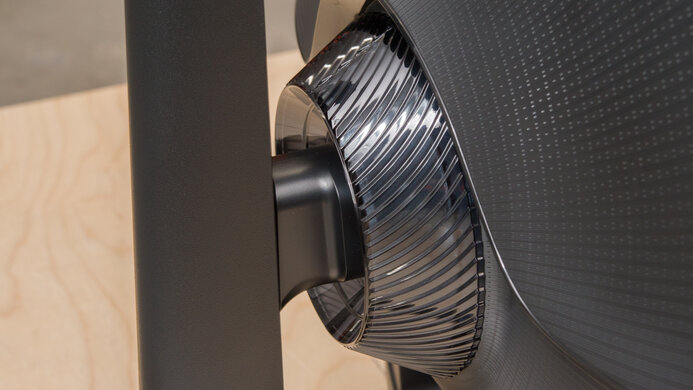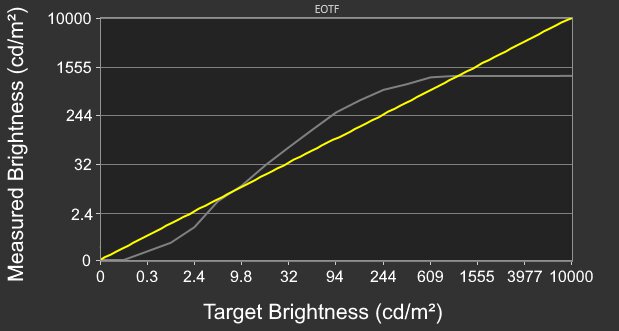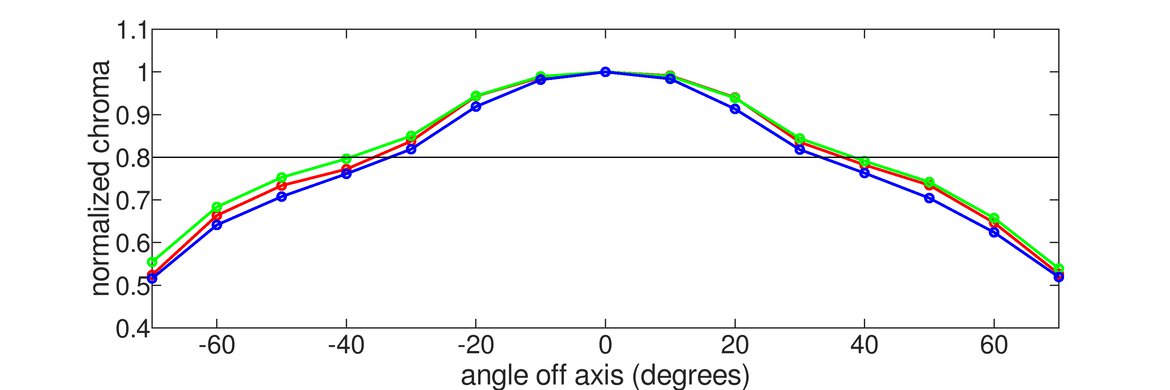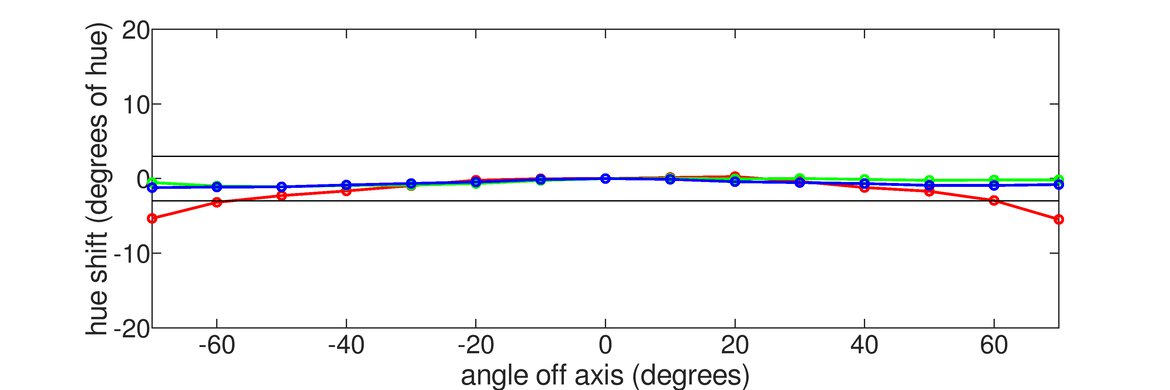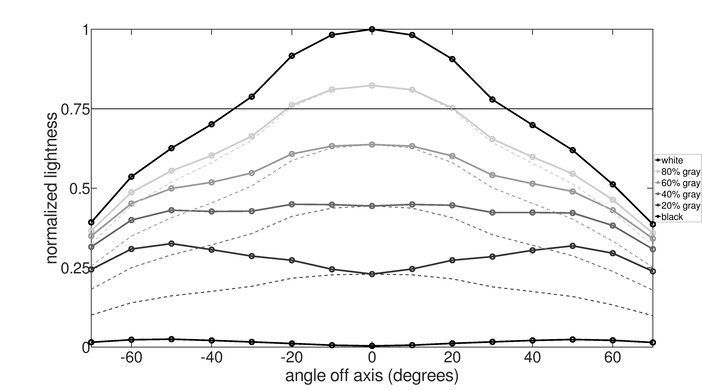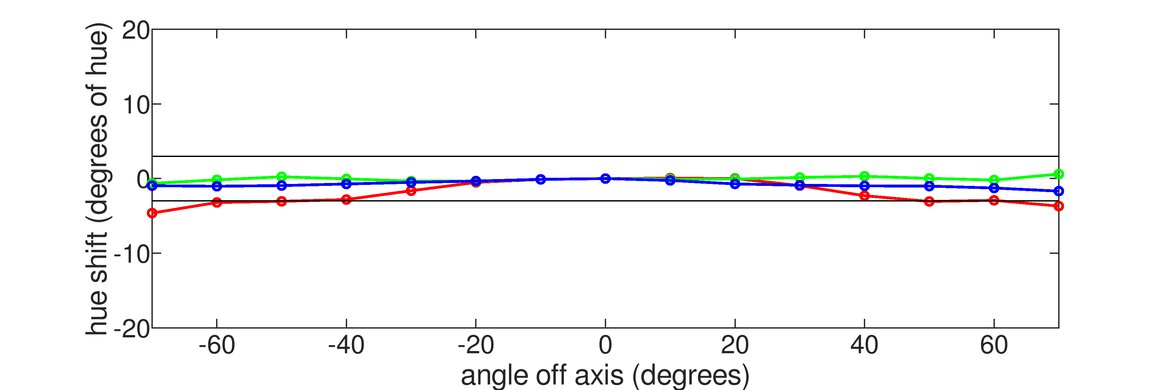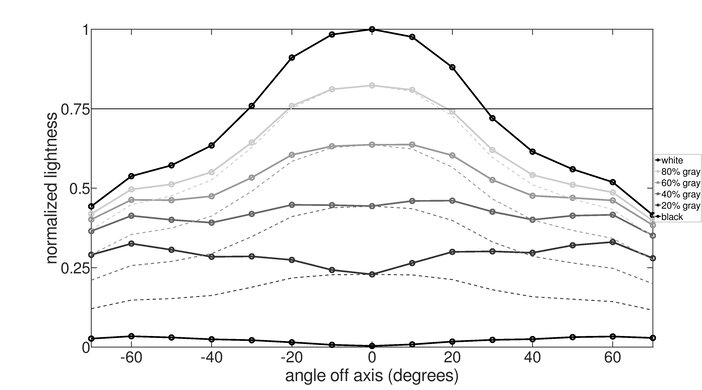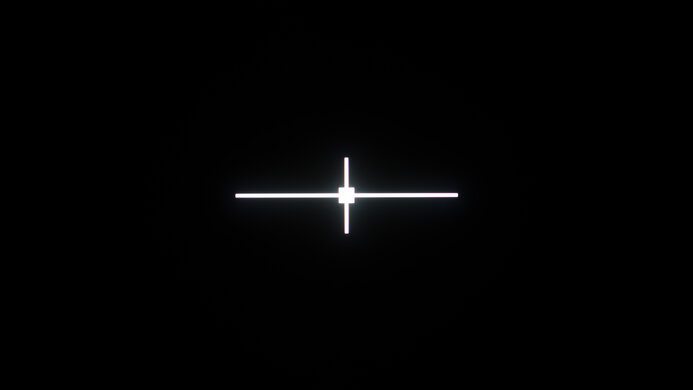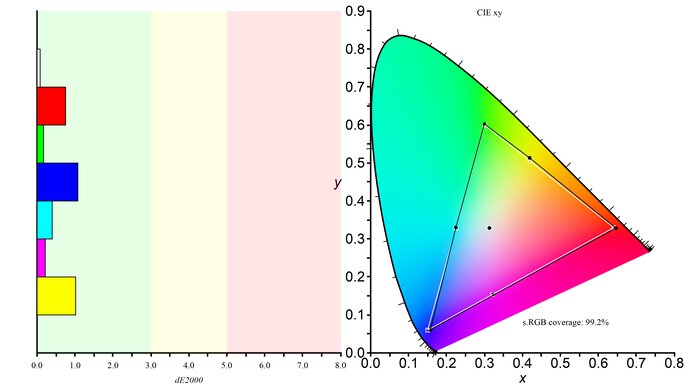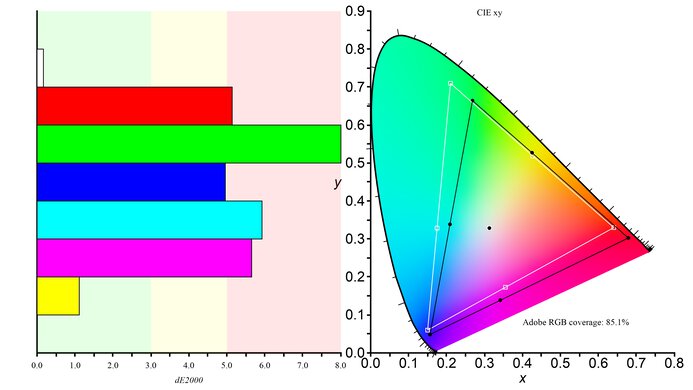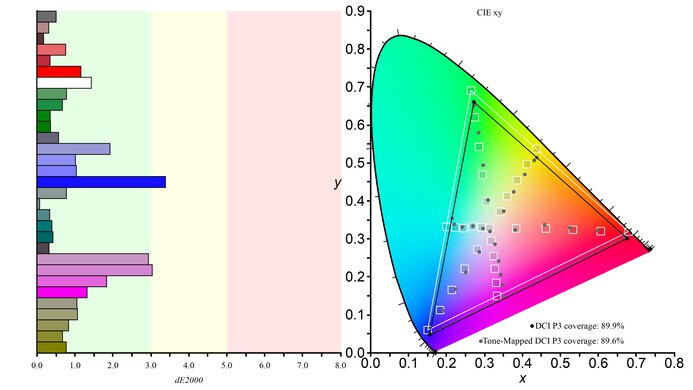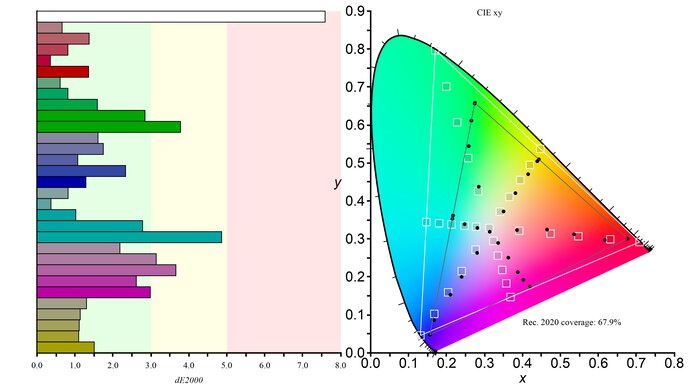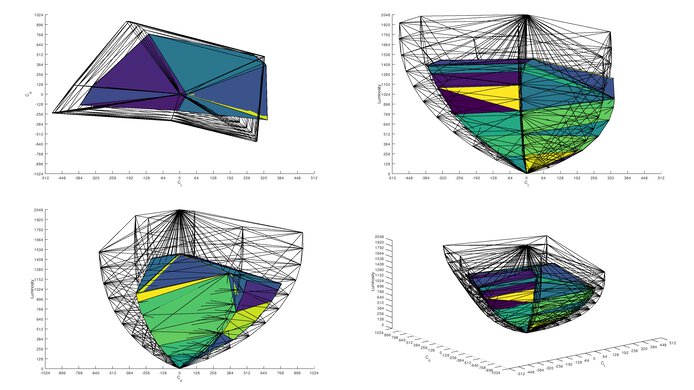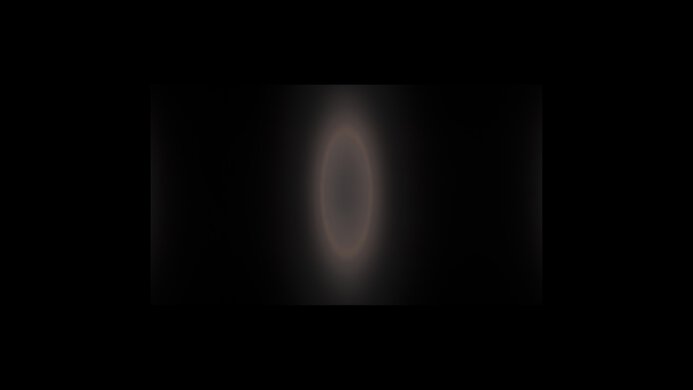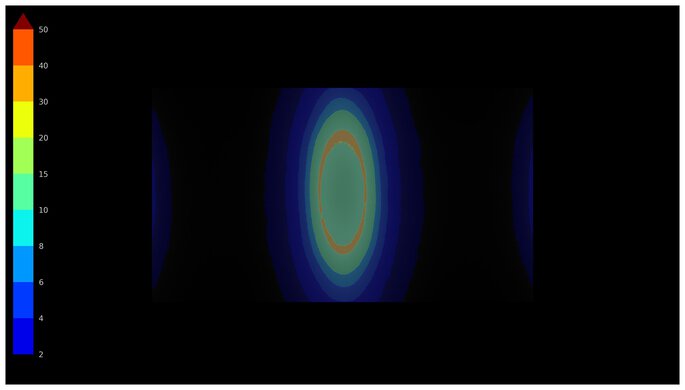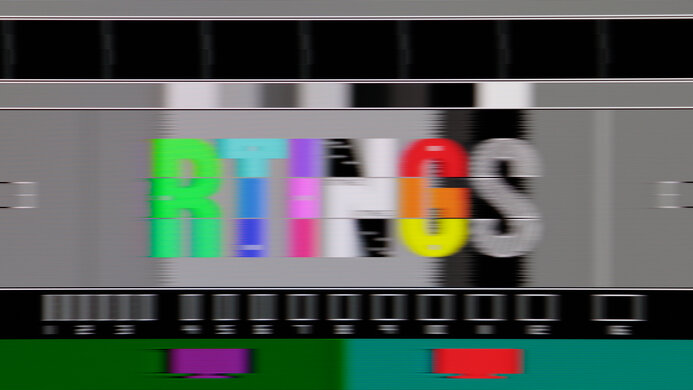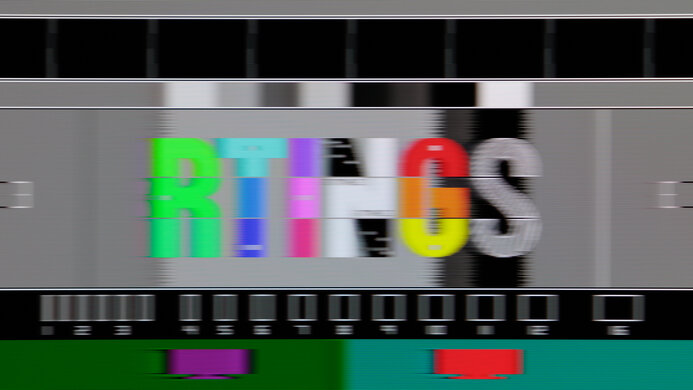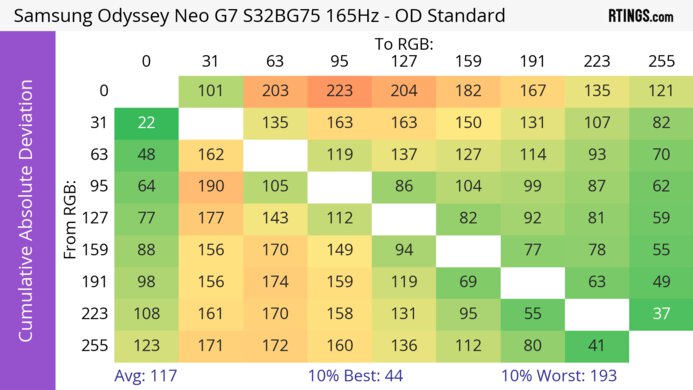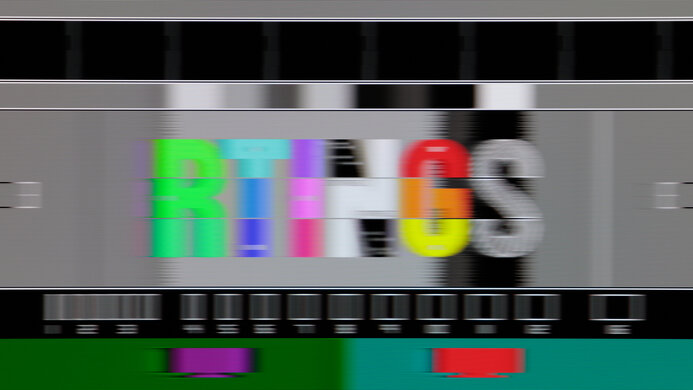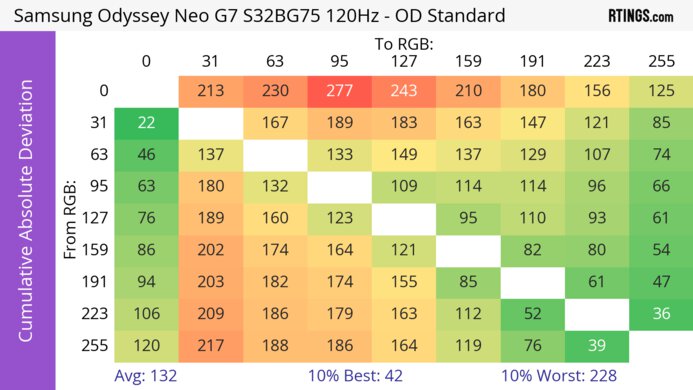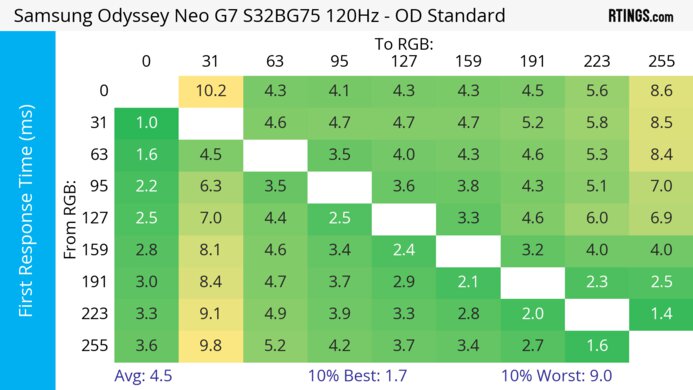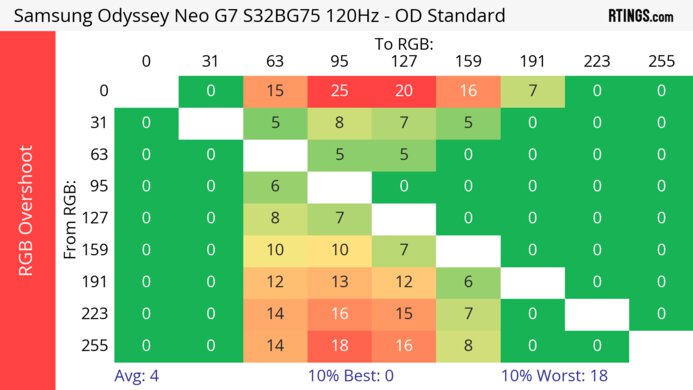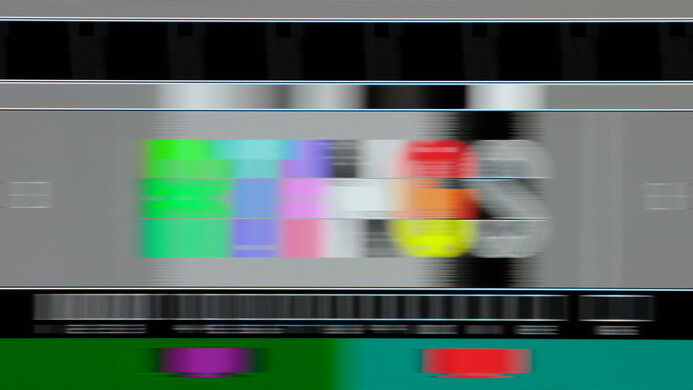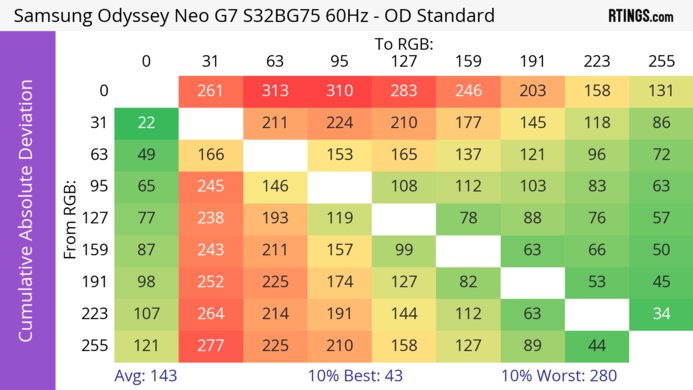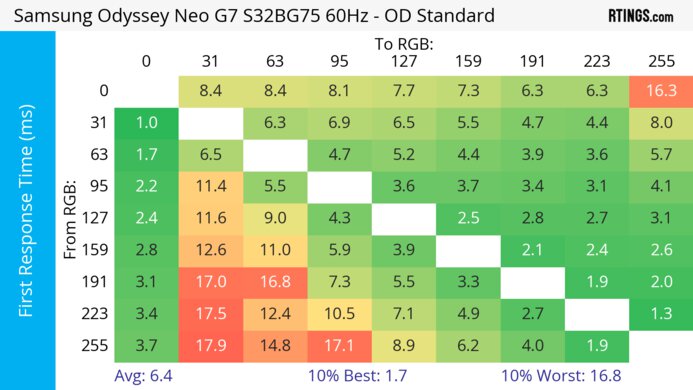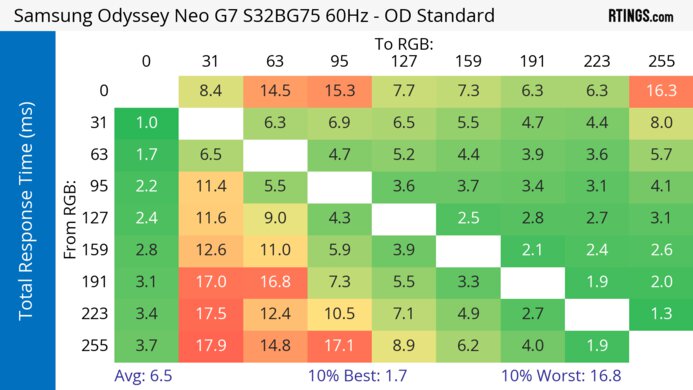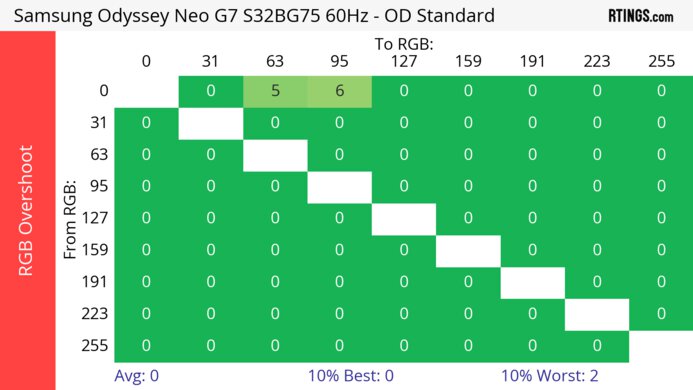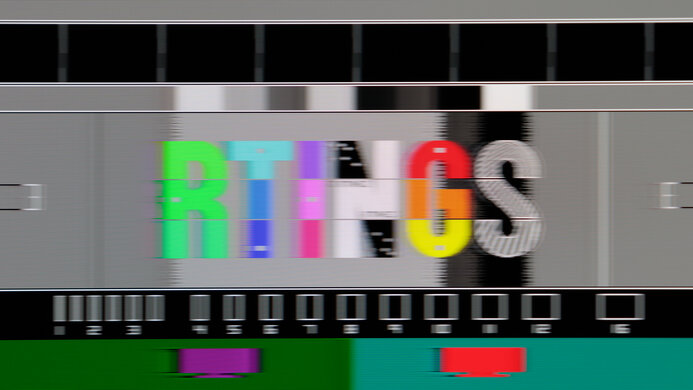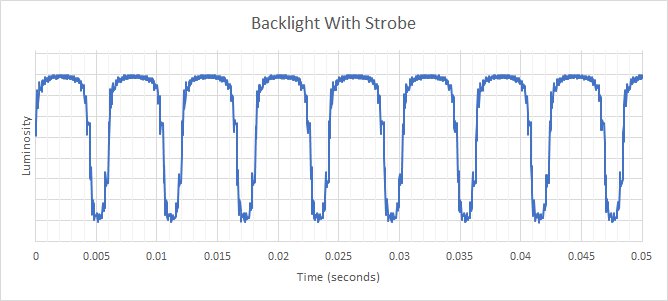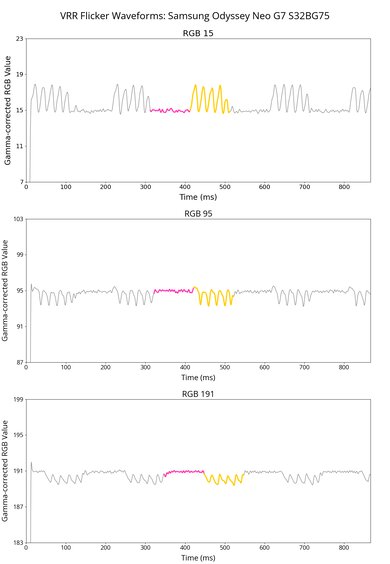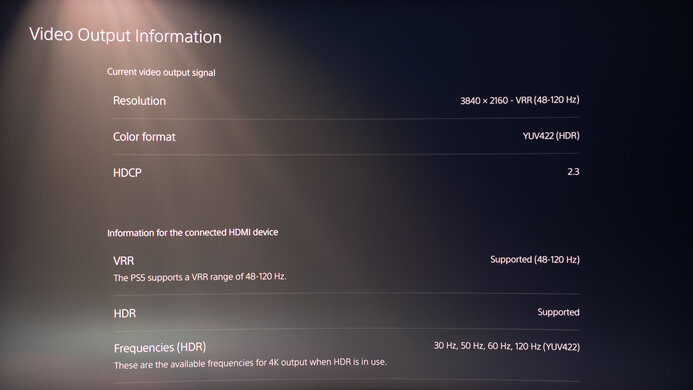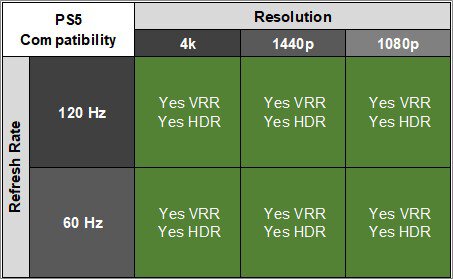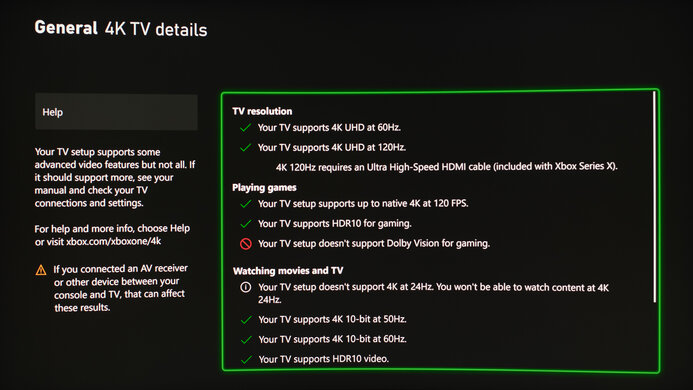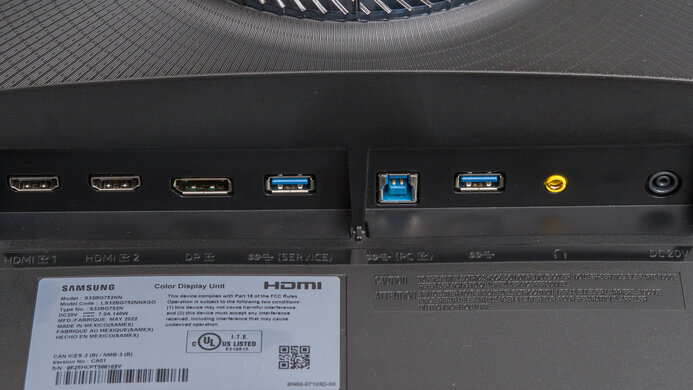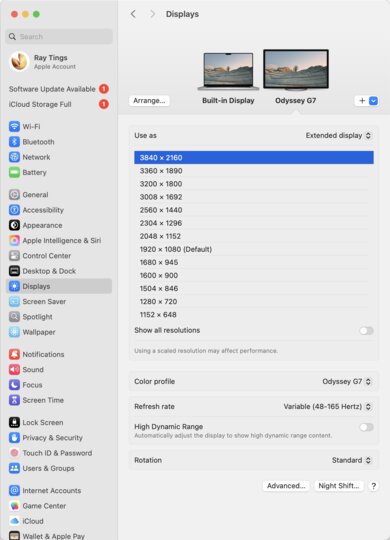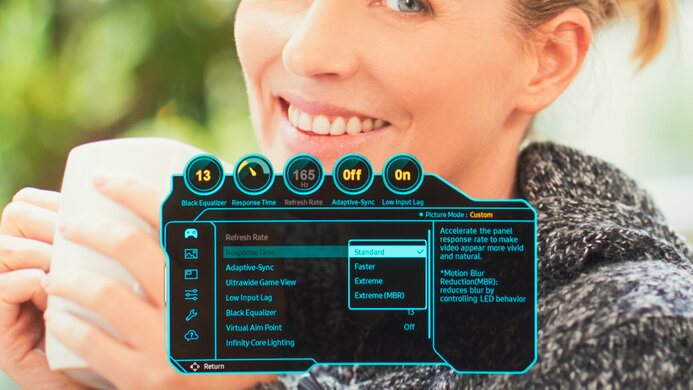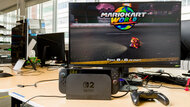The Samsung Odyssey Neo G7 S32BG75 is a 32-inch 4k monitor that Samsung released in 2022. Part of the Odyssey gaming lineup, it's different from other G7 models like the Samsung Odyssey G7/G70B S32BG70 because it uses Mini LED backlighting and quantum dot technology to display a wider range of colors, similar to the higher-end Samsung Odyssey Neo G8 S32BG85. It also features a 1000R curved screen to bring the edges more within your field of vision. It focuses on both console and PC gaming because it has a 165Hz refresh rate, VRR support, and HDMI 2.1 bandwidth that allows you to play 4k games at a high frame rate, as long as your graphics card supports it.
Our Verdict
The Samsung Odyssey Neo G7 is very good for PC gaming. It has a 165Hz refresh rate with VRR support to reduce screen tearing. It has low input lag for a responsive feel and motion looks sharp for the most part, but there's more inverse ghosting at lower refresh rates with VRR enabled. It also has noticeable VRR flicker with changing frame rates, which is mostly distracting in dark scenes. On the plus side, it delivers good picture quality thanks to its decent local dimming feature and high brightness that makes small highlights pop.
- Supports all common VRR formats.
- Fast response time with most refresh rates.
- Decent local dimming.
- Small highlights pop against dark backgrounds.
- Low input lag with most settings.
- Distracting VRR flicker with changing frame rates.
- Some blooming around bright objects.
- More inverse ghosting at lower refresh rates.
The Samsung Neo G7 is excellent for console gaming. It takes full advantage of the PS5 and Xbox Series X|S due to its HDMI 2.1 bandwidth, and it delivers detailed images thanks to its 4k resolution. Motion looks sharp, but it doesn't eliminate all blur, and it has low enough input lag for a responsive feel, which is great for playing reaction-based games. It also provides life-like images, especially when playing HDR games, as it has a decent local dimming feature that helps it display deep blacks, and colors are vivid.
- HDMI 2.1 bandwidth.
- Fast response time with most refresh rates.
- Decent local dimming.
- Small highlights pop against dark backgrounds.
- Low input lag with most settings.
- Some blooming around bright objects.
- More inverse ghosting at lower refresh rates.
The Samsung Odyssey Neo G7 is great for office use. The 32-inch screen and high 4k resolution are good enough to open multiple windows at once, and the text clarity is fantastic. It also has okay reflection handling, and it gets bright enough to fight glare, but there are distracting changes in the brightness when you leave the local dimming feature on. Sadly, it has narrow viewing angles that make the image look washed out from the sides.
- 4k resolution results in sharp text.
- Bright enough to fight glare.
- Great ergonomics.
- Narrow viewing angles.
The Samsung Neo G7 is great for content creators. With a 32-inch screen and 4k resolution, you can edit photos and videos with sharp detail and see more of your work area at once. It also has excellent overall ergonomics that make it easy to adjust, but with a curved screen and narrow viewing angles, it's hard to share the screen with someone else next to you. While it displays a wide range of colors and has decent accuracy before calibration, you still need to calibrate it for the best accuracy.
- 4k resolution results in sharp text.
- Bright enough to fight glare.
- Great ergonomics.
- High contrast ratio.
- Narrow viewing angles.
- Some blooming around bright objects.
- Needs full calibration for best accuracy.
The Samsung Odyssey Neo G7 has good brightness. It gets bright enough to fight glare in a well-lit room. It also gets bright in HDR, making small highlights pop, but it can't maintain that high peak brightness with larger objects.
- Bright enough to fight glare.
- Small highlights pop against dark backgrounds.
- Larger highlights don't stand out.
The Samsung Neo G7 has a great response time that makes motion look sharp, but it doesn't eliminate all blur. Also, there's more inverse ghosting at lower refresh rates, which can get distracting.
- Fast response time with most refresh rates.
- More inverse ghosting at lower refresh rates.
The Samsung Odyssey Neo G7 is great for HDR. It has a high contrast ratio to make blacks look deep, and the decent local dimming feature helps improve the picture quality in dark scenes, but there's still some blooming around bright objects. It also displays a wide range of colors in HDR, and it makes them look vivid.
- Decent local dimming.
- High contrast ratio.
- Displays wide range of colors.
- Some blooming around bright objects.
The Samsung Neo G7 has great picture quality in SDR. It displays a wide range of colors and has a good native contrast ratio, but there's backlight bleed in dark scenes with local dimming disabled.
- High contrast ratio.
- Displays wide range of colors.
- Some blooming around bright objects.
The Samsung Odyssey Neo G7 has very good color accuracy. You need to calibrate it for the best accuracy, but once you do, it has good gray uniformity that keeps the image consistently accurate over the entire screen.
- Displays wide range of colors.
- Needs full calibration for best accuracy.
Performance Usages
Changelog
- Updated Aug 06, 2025:
We checked the macOS Compatibility after updating our MacBook to Sequoia 15.5, and confirmed it reaches a 165Hz refresh rate now.
- Updated Jul 23, 2025:
We updated text throughout to match the new and updated tests with Test Bench 2.1, including in the Verdict section.
- Updated Jul 21, 2025: We've converted this review to Test Bench 2.1. This includes new tests for Direct Reflections, Ambient Black Level Raise, and Total Reflected Light. You can see all the changes in the changelog.
- Updated Feb 21, 2025: We've converted this review to Test Bench 2.0.1. This includes a new test result for DisplayPort 2.1 Transmission Bandwidth.
Check Price
Differences Between Sizes And Variants
We tested the 32-inch Samsung Neo G7, which is the only size available, and the results are only valid for this model. There are other models in Samsung's Odyssey lineup that share the G7 name, but they're different monitors. They also have the higher-end Samsung Odyssey Neo G8 S32BG85, which is very similar to the Neo G7 but has a higher 240Hz refresh rate. You can see the differences between them below.
| Size | Name | US Model Code | Resolution | Refresh Rate | Panel Type | Mini LED | Tizen OS | Release Year |
|---|---|---|---|---|---|---|---|---|
| 28" | Odyssey G7 S28AG70 | LS28AG700NNXZA | 4k | 144Hz | IPS | No | No | 2021 |
| 32" | Odyssey G7 S32BG70 | LS32BG702ENXGO | 4k | 144Hz | IPS | No | Yes | 2022 |
| 32" | Odyssey Neo G7 S32BG75 | LS32BG752NNXGO | 4k | 165Hz | VA | Yes | No | 2022 |
| 32" | Odyssey Neo G8 S32BG85 | LS32BG852NNXGO | 4k | 240Hz | VA | Yes | No | 2022 |
| 43" | Odyssey Neo G7 S43CG70 | LS43CG702NNXZA | 4k | 144Hz | VA | Yes | Yes | 2023 |
Our unit was manufactured in May 2022, and you can see the label here. The monitor was tested with firmware M-B7532GGZA-1009.0.
Popular Monitor Comparisons
The Samsung Odyssey Neo G7 S32BG75 is a great gaming monitor with useful features like the 165Hz refresh rate and HDMI 2.1 bandwidth. Its Mini LED backlighting provides better picture quality in dark rooms than many other LED-backlit 32-inch monitors, including the LG 32GQ950-B. It's a good cheaper alternative to the Samsung Odyssey Neo G8 S32BG85 if you don't need such a high refresh rate, but like the S32BG85, it has noticeable VRR flicker with changing frame rates in dark scenes. That said, this isn't so much of an issue if your PC can maintain consistent frame rates.
Also see our recommendations for the best HDR gaming monitors, the best 4k HDR monitors, and the best 4k gaming monitors.
The Samsung Odyssey Neo G7 S32BG75 is better than the Sony INZONE M9. The Samsung has a much more versatile stand, so it's easier to place it in an ideal viewing position or turn the screen to share it with someone else. The Samsung also has much better contrast, delivering deeper blacks in a dark room and less blooming around bright objects thanks to its Mini LED backlight.
The Samsung Odyssey Neo G8 S32BG85 and the Samsung Odyssey Neo G7 S32BG75 are very similar monitors. They likely use the same panel as the picture quality is the same, but the main difference is that the Neo G8 has a 240Hz refresh rate, while the Neo G7 has a 165Hz refresh rate. Another difference is that the Neo G8 uses a different screen coating with much better reflection handling. However, it introduces some haziness, so if that bothers you, the Neo G7 is the better choice.
The Samsung Odyssey Neo G7 S32BG75 is a higher-end version of the Samsung Odyssey G7/G70B S32BG70, so it's better overall. The main difference is that the Neo G7 has a VA panel with Mini LED backlighting, resulting in a much better contrast and local dimming feature. It also gets brighter in HDR, particularly with smaller highlights. On the other hand, the G70B has better motion handling as there's less overshoot.
The Samsung Odyssey Neo G7 S32BG75 is a newer version of the Samsung Odyssey G7 C32G75T, and both monitors are very different. The S32BG75 has a 4k screen with HDMI 2.1 bandwidth, allowing you to play high-frame-rate games in 4k, which the C32G75T can't do. The S32BG75 also has Mini LED backlighting with a much better local dimming feature than the C32G75T. If you want a high-end 4k monitor, the S32BG75 is the better choice, but the C32G75T is better if your graphics card can't take full advantage of the 4k resolution.
Test Results

This monitor has great build quality. It's mainly plastic that feels good, and the base of the stand is metal. The stand is easy to adjust, and it holds the screen well. There's a bit of wobble on the stand, but this is only an issue if you don't have a stable desk. Overall, it feels well-made, and there aren't any major issues of concern.
The ergonomics are great. You can adjust it in several ways, but its swivel range is a bit narrow, which is disappointing if you often need to turn the screen for someone next to you. The stand has a clip for cable management to route your cables to the inputs.
The stand has wide-set metal feet that support the screen well, but they don't prevent all wobble. Due to the large footprint of the stand, you'll need a big desk to put it on.
This monitor has a decent Mini LED local dimming feature that has a 46x26 array with 1,196 dimming zones. With Local Dimming on 'High', HDR content looks great because small highlights pop against dark backgrounds, but it struggles to make larger highlights pop in bright scenes. There's some blooming that's more noticeable if you're viewing the screen from the sides than from in front. The blooming isn't always present, but it can be visible in some scenes, like moving the mouse against a dark background or around players in FIFA. There's some blooming around subtitles too, but it's still better than most monitors. That said, there's less blooming than on non-Mini LED monitors.
Sadly, there's black crush in darker scenes, causing you to lose fine details. Also, the local dimming enables the Dynamic Brightness setting, which can be distracting as minimizing and maximizing windows in the desktop causes a change in brightness. The algorithm keeps up with fast-moving content well, but there's some blur trail behind fast-moving objects with it on 'High'.
The SDR peak brightness is great. With the Local Dimming on 'High', it gets bright enough to fight glare, but it has an aggressive Automatic Brightness Limiter that's distracting when you're miniziming and maximizing windows, even with Local Dimming on 'Low', but isn't so much of an issue with static content. You can either set the brightness to a really low level, or you can simply disable the local dimming to avoid an aggressive ABL, and the monitor is still bright enough to fight glare:
- Peak 2% Window: 316 cd/m²
- Peak 10% Window: 316 cd/m²
- Peak 25% Window: 315 cd/m²
- Peak 50% Window: 314 cd/m²
- Peak 100% Window: 314 cd/m²
- Sustained 2% Window: 316 cd/m²
- Sustained 10% Window: 316 cd/m²
- Sustained 25% Window: 315 cd/m²
- Sustained 50% Window: 314 cd/m²
- Sustained 100% Window: 313 cd/m²
These results are from after calibration in the 'Custom' Picture Mode.
The Samsung Odyssey Neo G7 has decent HDR peak brightness. It gets really bright with small highlights as they stand out and pop against a dark background, but it gets dimmer with larger areas of bright colors. Unfortunately, the EOTF doesn't follow the target PQ curve well, as it crushes blacks and over-brightens brighter details. However, because there's a sharp cut-off at the peak brightness, it lets your computer do any tone mapping.
Samsung advertises Quantum HDR 2000, but this isn't a real VESA certification, and it doesn't hit 2000 nits.
These results are in the 'Custom' Picture Mode with the Brightness at its max and Local Dimming set to 'High'. The EOTF is also similar with Local Dimming set to 'Low', as you can see here, but then the screen is dimmer.
If you want a monitor with Mini LED backlighting that gets brighter, then look into the AOC Q27G3XMN.
This monitor has a narrow horizontal viewing angle. The image looks washed out from the sides, but the curved screen helps bring the edges closer to you if you sit directly in front. If you want a 32-inch, 4k monitor with better viewing angles, look into the Acer Predator X32 Fpbmiiiiphuzx.
The vertical viewing angle is disappointing. The image looks washed out if you're standing up and looking down on the monitor.
This monitor has good black uniformity if you have the Mini LED local dimming feature enabled. It helps it display deep blacks without too much blooming around bright objects. However, the uniformity is worse without local dimming as there's backlight bleed along the top and bottom edges. If you prefer a monitor that has perfect black uniformity thanks to its OLED panel, check out the Dell Alienware AW3423DWF.
The Samsung Odyssey Neo G7 has decent accuracy before calibration. The sRGB mode locks the colors to the sRGB space, but the white balance is off, and gamma doesn't follow the target sRGB curve well, as dark scenes are too dark and bright scenes are over-brightened. The sRGB mode locks the Contrast, Color, Black Level, and Screen Adjust settings, but not the brightness. If you want to change the other settings, you'll need to use other picture modes that are less accurate with oversaturated colors, as you can see here.
The accuracy after calibration is fantastic, and any remaining inaccuracies can't be spotted by the naked eye. Gamma and the color temperature are both nearly spot-on with their targets.
This monitor has an incredible SDR color gamut. It has perfect coverage of the sRGB color space used in most web content, and it has good Adobe RGB coverage, but it undersaturates greens and oversaturates reds.
The Samsung Neo G7 has a great HDR color gamut. It has amazing DCI-P3 coverage, which is the common color space used in most HDR content. However, it has more limited coverage of the Rec. 2020 color space with tone mapping issues.
Unlike past Samsung monitors, there aren't dedicated HDR picture modes like 'HDR Dynamic' or 'HDR Game', and instead the HDR picture modes are the same as in SDR, but they perform differently. You can also change picture settings like Contrast, Sharpness, and Color.
The direct reflection handling is okay. The matte coating spreads light out, but it still has some mirror-like reflections. It doesn't absorb light as well as the Samsung Odyssey Neo G8 S32BG85, which has a more aggressive coating. Objects also look warped because of the curved screen.
The black levels remain low in a bright room, which is excellent.
There's some reflected light on this monitor in a bright room that could get distracting, but it's not the worst either. The main downside is that there's still strong glare from bright light sources, and it warps images due to its curved screen.
| NVIDIA | VRR Min | VRR Max |
| DisplayPort | <20Hz | 165Hz |
| HDMI | <20Hz | 165Hz |
| AMD | VRR Min | VRR Max |
| DisplayPort | <20Hz | 165Hz |
| HDMI | <20Hz | 165Hz |
On top of supporting FreeSync VRR and G-SYNC compatibility, this monitor also supports HDMI Forum VRR.
| Refresh Rate | CAD Heatmap | RT Chart | Pursuit Photo |
| 164 | Heatmap | Chart | Photo |
| 144 | Heatmap | Chart | Photo |
| 120 | Heatmap | Chart | Photo |
| 100 | Heatmap | Chart | Photo |
| 80 | Heatmap | Chart | Photo |
| 60 | Heatmap | Chart | Photo |
The motion handling across the VRR range is great. Using VRR disables any of the overdrive settings, and while there isn't too much noticeable blur, there's more inverse ghosting at lower refresh rates, which is disappointing if your PC can't maintain a consistently high frame rate.
The refresh rate compliance is very good. While its response time isn't fast enough to take full advantage of its max refresh rate, it gets better at lower refresh rates.
| Overdrive Mode | CAD Heatmap | RT Chart | Pursuit Photo |
| Standard | Heatmap | Chart | Photo |
| Faster | Heatmap | Chart | Photo |
| Extreme | Heatmap | Chart | Photo |
| VRR | Heatmap | Chart | Photo |
The CAD at the max refresh rate is impressive. If you disable VRR you can use the overdrive settings, in which case 'Standard' has a lot less inverse ghosting than 'Faster' and 'Extreme'. However, even using VRR results in similar motion handling.
| Overdrive Mode | CAD Heatmap | RT Chart | Pursuit Photo |
| Standard | Heatmap | Chart | Photo |
| Faster | Heatmap | Chart | Photo |
| Extreme | Heatmap | Chart | Photo |
| VRR | Heatmap | Chart | Photo |
The CAD at 120Hz is great. Like at the max refresh rate, if you disable VRR, the recommended overdrive setting is 'Standard' because it has less inverse ghosting than 'Faster' and 'Extreme', but there's still a bit of noticeable blur and inverse ghosting. Motion is similar even if you enable VRR.
| Overdrive Mode | CAD Heatmap | RT Chart | Pursuit Photo |
| Standard | Heatmap | Chart | Photo |
| Faster | Heatmap | Chart | Photo |
| Extreme | Heatmap | Chart | Photo |
| VRR | Heatmap | Chart | Photo |
The CAD at 60Hz is very good. It performs similarly to higher refresh rates as there's a bit of blur, but it isn't overly distracting either. Without VRR, the 'Standard' overdrive setting once again performs the best, and using VRR results in similar motion handling.
The Samsung Odyssey Neo G7 has an optional backlight strobing feature, commonly known as black frame insertion. It only works properly within a narrow range and there's flicker below 120Hz. Enabling the feature also locks the VRR and local dimming features. The pulse phase isn't matched up to the refresh rate, so the timing is constantly shifting, which means there's noticeable image duplication at times, and it looks better at other times. The BFI features also locks the brightness setting, but if you set the brightness before enabling the BFI, it stays on that brightness.
Unfortunately, there's noticeable VRR flicker with changing frame rates. It's distracting in both dark and bright scenes, but this isn't so much of an issue if you have a consistent frame rate. Samsung added a VRR Control setting to eliminate this flicker. Using it can improve the flicker, but it also increases input lag, so the best way to avoid this flicker is by using a consistent frame rate.
The Samsung Neo G7 has a flicker-free backlight with the brightness at higher levels, which helps reduce eye strain. With the local dimming disabled, the flicker starts with the brightness set to '10' or lower, and the flicker is high enough that you won't notice it. However, the pulse width modulation (PWM) behaves differently with the local dimming enabled. With the brightness at '19', it flickers at 240Hz, and the flicker fluctuates as the brightness goes down until it's at 165Hz with the brightness at '0'. This flicker is more noticeable as you lower the brightness, so if a bright screen doesn't bother you, it's best to leave it at high brightness, especially if you have local dimming enabled. You can see the flicker chart with the Local Dimming on 'High' here.
Another issue is with scanlines. Scanlines are most noticeable with test patterns, like patterns 2a and 2b from Lagom. You can see an example of the scanlines in the green section here and you can also see it more clearly with a zoomed-in image here. Other test patterns cause the scanlines, and you can see an image of what the scanlines look like here. This video is a good example to see the scanlines and flicker issues in the green section with the Local Dimming set to 'High', VRR enabled, VRR Control off, and the Brightness at '100'. Keep in mind that these scanlines are most noticeable with test patterns, and they're hard to see and rarely happen with real content. If you notice them, lowering the Sharpness can help reduce the issue, but it doesn't completely fix it.
The Samsung Odyssey Neo G7 has low input lag for a responsive feel when gaming. Unlike past Samsung monitors, the input lag doesn't increase when the frame rate of your source drops below the set refresh rate of the monitor. Unfortunately, the VRR Control setting increases the input lag, as you can see below:
| Setting | VRR Control On | VRR Control Off | Local Dimming |
| 165 fps | 10.8 ms | 4.3 ms | 4.8 ms |
| 120 fps | 15.4 ms | 5.2 ms | 5.8 ms |
| 60 fps | 23 ms | 9.1 ms | 9.7 ms |
The Samsung Odyssey Neo G7 is fully compatible with the PS5 thanks to its HDMI 2.1 bandwidth. Both the 'PC' and 'AV' modes in the monitor's OSD perform the same, and neither have an impact on text clarity. The 'AV' modes lock you out of the regular Picture Modes available, including sRGB, while you can still use those modes in the 'PC' mode.
It doesn't have a USB-C input but if you want a similar 4k monitor that does, then look into the Cooler Master Tempest GP27U.
Tested with: M3 MacBook Pro (Sequoia 15.5)
| Connection | HDMI 2.1 | USB-C to DP |
|---|---|---|
| Max Refresh Rate | 165Hz | 165Hz |
| VRR Range | 48-165Hz | 48-165Hz |
| HDR | Yes | Yes |
The Samsung Odyssey Neo G7 works well with macOS. You can reach the max refresh rate with any connection, but you may need to update your Mac's operating system to reach it. Unfortunately, there's noticeable flicker with the VRR Control setting disabled. Enabling it eliminates this flicker, but it also increases the input lag. HDR looks okay, as highlights pop, but some colors look a bit washed out. Also, windows return to their original position after the monitor goes to sleep when using a MacBook, but they don't if you close the laptop lid.
The Samsung Odyssey Neo G7 has a few extra features to improve your gaming experience, like:
- Black Equalizer: Adjusts the gamma so that you can see opponents better in dark areas of games.
- Dynamic Brightness: Brightens the screen on a scene-by-scene basis. Automatically enabled with Local Dimming on.
- Eco Light Sensor: Changes the brightness of the screen according to the ambient environment.
- Eye Care: Removes blue light to help with eye strain.
- Infinity Core Lighting: Controls the lighting on the stand, and can sync with the on-screen colors.
- Ultrawide Game View: Displays an ultrawide 21:9 image, with black bars at the top and bottom.
- Virtual Aim Point: Displays a crosshair that your system won't detect.



